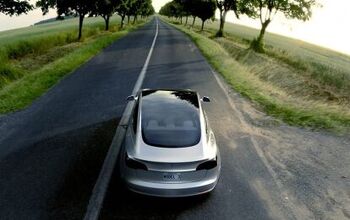The Curious Case Of Honda's Missing Mojo
Though the US auto market is up 11 percent this year, Honda’s sales are up only 3.6 percent compared to last year’s weak performance. That means the Motor Company isn’t even keeping up with the growth rates of such maligned brands as Lincoln (+7.4%), Chrysler (+16%) and Mazda (+9.8%). But Team Honda isn’t sweating the details. After all, the Civic and CR-V are nearing the end of their model cycles, while the Accord is a year and a half from its replacement. And, as Honda USA’s Executive VP John Mendel tells Automotive News [sub], at Honda
no one talks about share. Chasing share gets you into bad habits. We set a business plan to sell a certain number of cars. We don’t set the plan based on an assumed share. We plan to grow 2 or 3 percent in volume in good times, and bad times. And there are times we’ll give share back.Which is the kind of thing you’d expect to hear from an exec in Mendel’s situation… unfortunately, there are troubling indicators on the horizon that could cause Honda’s “bad times” to go on longer than anyone expected.Oregon dealer Theis, a 25-year Honda veteran, said increasingly complicated model proliferation has taxed the current MOVE system. It’s about more than just days’ supply on a dealer’s lot going toward turn-and-earn; it determines what vehicles can be ordered at a particular time.
Large and small dealers agree that Honda’s inventory, allocation and manufacturing systems are not properly aligned, requiring a combination of mathematics and luck to get the right cars in stock.
The new Odyssey is an example of what frustrates dealers. With pricey options such as rear-seat video, power tailgate and leather seats, the new van has many more trim levels and features. Dealers believe they are better judges of local tastes than are factory reps.
“Right now we can choose within certain build constraints each month, but that can still be reconfigured by the factory,” said Theis. “Dealers say if they could get the cars they want, and get more local control, they could grow.”
So, in a year and a half, Honda could have a new Civic, a new CR-V, a new Accord and a new, improved inventory management system… but that’s a huge amount of problems to fix in 18 months. Meanwhile, with GM, Hyundai, Subaru and Ford roaring up the sales charts, nobody is sitting around waiting for Honda to snap out of its funk. Meanwhile, Honda’s got just a few strengths to keep it going: its inventories remain low, and its loyalty remains high. But if it doesn’t start fixing everything else, Honda could just find itself out of favor with consumers, dependent on trucks, and unable to deliver the cars consumers want to where they’re in demand. Does this sound anything like the Honda Americans have grown to love?More by Edward Niedermeyer
Latest Car Reviews
Read moreLatest Product Reviews
Read moreRecent Comments
- Calrson Fan Jeff - Agree with what you said. I think currently an EV pick-up could work in a commercial/fleet application. As someone on this site stated, w/current tech. battery vehicles just do not scale well. EBFlex - No one wanted to hate the Cyber Truck more than me but I can't ignore all the new technology and innovative thinking that went into it. There is a lot I like about it. GM, Ford & Ram should incorporate some it's design cues into their ICE trucks.
- Michael S6 Very confusing if the move is permanent or temporary.
- Jrhurren Worked in Detroit 18 years, live 20 minutes away. Ren Cen is a gem, but a very terrible design inside. I’m surprised GM stuck it out as long as they did there.
- Carson D I thought that this was going to be a comparison of BFGoodrich's different truck tires.
- Tassos Jong-iL North Korea is saving pokemon cards and amibos to buy GM in 10 years, we hope.


































Comments
Join the conversation
Clearly Honda is no longer interested in being what enthusiasts think of as "Honda". My personal theory is that, lacking Soichiro's vision, they simply want to be Toyota...and that being second in these segments is not working. Evidence: Accord = second-rate Avalon. Odyssey = second-rate Sienna. CR-Z = bastard child of Paseo and Prius. Civic = overweight stripper = Corolla. Element = failed xB. Crosstour = worse than Venza, no small feat. S2000, TSX = Supra. Not easy for this Honda owner to say so, but case closed. I've moved on.
I have to admit, I've never understood the appeal of most of Honda's products, cars anyway. They always seemed to be totally without personality, just "driving appliances" as some people put it. Their "styling" has gotten worse over time, more bizarre. I used to think Ford's styling was bizarre, but Honda and Toyota have taken over as Ford seems to have somehow regained their sanity after nearly 40 years of one ugly vehicle after another. I guess part of why I never understood the whole Honda love is the lack of any RWD vehicles. I have no real interest in FWD 4cyl cars. I work next door to a Honda dealer, and I see the cars going in and out, and they really have some unattractive cars on the lot right now. I had my new camcorder at work, and it amused the hell out of me when it's facial recognition kept locking onto the front of many of the new Hondas going in and out of the lot. The Acura lot down the road has even uglier stuff on the lot, and the face recognition locks onto almost everything there.